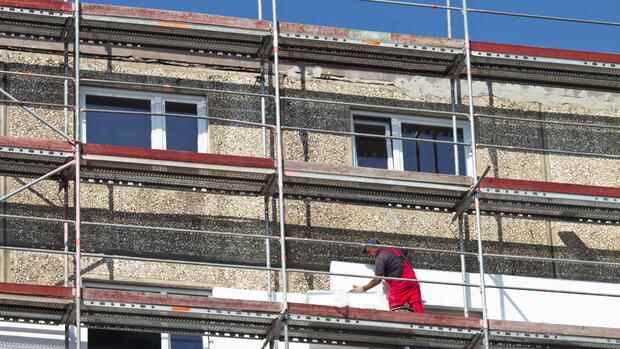Berlin The Federation of German Industries (BDI) warns the traffic light government against delaying the renovation of buildings. “Politics must finally set the course for the long overdue wave of renovations in Germany,” said Holger Loesch, deputy BDI general manager, to the Handelsblatt.
“Buildings play a key role in achieving climate targets and ensuring a stable energy supply,” said Loesch. “Buildings account for around 30 percent of German CO2 emissions and 30 percent of the consumption of Russian gas imports.”
Nevertheless, the renovation rate has been too low for years and CO2 emissions are too high. It was not until March that the Federal Environment Agency determined that the building sector released more greenhouse gases in 2021 than required by the Federal Climate Protection Act. The Expert Council for Climate Issues has now confirmed the figures. The Ministry of Construction must now submit an immediate program by mid-July.
Top jobs of the day
Find the best jobs now and
be notified by email.
On the basis of a twelve-point plan that has not yet been published, the BDI outlines central measures as to how building refurbishment could be promoted in view of the urgently required independence from Russian energy. The plan is available to the Handelsblatt.
Incentives for renovations
According to the BDI, targeted incentives are needed for more comprehensive and faster energy-efficient building renovations. The association has an unspecified “Sprinter bonus” in mind, with which politicians can support the renovation of buildings to a climate-neutral status by 2030. From 2030, the subsidy rates should decrease by one percentage point each year. That would give an impetus for early renovations.
Thermogram of a residential building: In Germany there is a large potential for saving energy in buildings.
(Photo: dpa)
In principle, politicians are aiming for a climate-neutral building stock by 2045. The BDI is therefore calling for an individual refurbishment plan for each building by 2028 at the latest, which shows building owners possible paths to climate neutrality by 2045. From 2029, individual measures should only be funded if they are included in a plan that points the way to “2045 maturity”, according to the BDI. The BDI proposes higher subsidy rates for particularly complex measures on the building envelope.
The federal government must give citizens and companies “quick clarity and planning security about the state funding offers,” says Loesch. In principle, all funding programs should run for at least ten years. Building owners would need time to gradually renovate their houses to be climate-neutral. The economy must also be able to build up the necessary production and craft capacities.
Renovation requirements
The BDI is in favor of prescribing the Efficiency House 70 standard for parts to be replaced when refurbishing existing buildings, as this would create the conditions for achieving climate neutrality by 2045.
In principle, the association rejects an obligation to carry out restructuring. If at all, an obligation should only apply to buildings in the lower efficiency classes, but should be designed with sufficient lead time and subsidies.
>>> Also read: The crux of the heat transition – what makes the switch to climate-friendly heating systems so difficult
The BDI is also skeptical about a solar roof requirement. House roofs are a fundamentally important source for the use of solar energy. And, according to the nine-page paper, this is an important lever to be able to better meet the increasing demand for renewable electricity in buildings and in general in the future. When introducing obligations, however, a sense of proportion is required in order not to overwhelm building owners.
heating exchange
From 2024, newly installed heating systems must be operated with 65 percent renewable energy. The BDI considers this to be “highly ambitious”, but nevertheless proposes a “Sprinter bonus” for those who modernize their heating so that it can be operated with 65 percent renewable energies from 2023, analogous to the funding for renovations.
For the vast majority of existing buildings with old oil or gas heating systems that have not yet been renovated, it will hardly be possible to do so quickly, especially since modern heating systems can often only be operated cost-effectively in combination with a renovation of the building envelope. “Accordingly, heating replacement and energetic modernization of the building envelope must be considered together and approached in a planned manner,” says the BDI.
The association also considers mandatory municipal heating planning to be indispensable, since heating or district heating networks, especially in urban areas, represent an alternative to heat pumps, for example, which are often used in detached and semi-detached houses. District heating networks are still often operated with fossil fuels.
“Building owners and district operators need clarity as to which options for CO2-neutral heat supply are available in the future,” it says. For this reason, municipal heating plans should be bindingly defined for urban areas by 2028 and transferred to network development plans.
More: With these measures, the energy demand in buildings can be reduced
